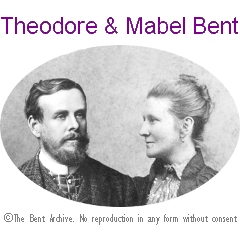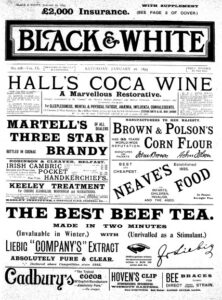
Theodore Bent had two articles published in the periodical Black & White on Lindos, Rhodes:
* ‘Lindos: The Living City of Homer’ – I (28 February 1891, pp. 109–10).
* ‘Lindos: The Living City of Homer – II’ (14 March 1891, pp. 173–4)
Black & White: A Weekly Illustrated Record and Review was a British Victorian-era illustrated weekly periodical founded in 1891 by Charles Norris Williamson. For the next decade or so it competed with other publications that vied with each other to exploit the new methods of printing (black and white) images, wrapped round with semi-consequential texts by, inter alia, celebrities. There were changes in direction as the market grew tougher, and the first issue of Black & White Budget appeared in October 1899 and it continued under that name until May 1903, after which it appeared as Black & White Illustrated Budget (until June 1905). There was one final issue on 24 June 1905 under the name Illustrated Budget. In 1912, it was incorporated with The Sphere and then disappeared. Ultimately it could not compete with the better-financed and more substantial organs, i.e. Illustrated London News, and The Graphic (to both of which Theodore Bent regularly contributed).
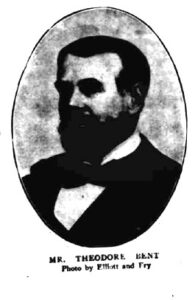
But returning to its launch enthusiasm, we read in The Freeman’s Journal of Wednesday, 4 January 1891, that: “At the offices of Black and White [sic], the new weekly illustrated paper which is to appear in February, a large reception was held on Monday night [2 January 1891]. The offices are at the corner of Fleet Street and Bouverie Street. The guests were received by Mr. C.N. Williamson, the managing editor, and Mr. Spielman, the art editor, was also to the fore. Among those present were… Mr. Jerome K. Jerome [he of Three Men in a Boat (To Say Nothing of the Dog) fame (1889)]… and Mr. and Mrs Theodore Bent…”
In all, Bent had three articles published in Black & White:
* ‘Lindos: The Living City of Homer’ – I (28 February 1891, pp. 109–10).
* ‘Lindos: The Living City of Homer – II’ (14 March 1891, pp. 173–4).
* ‘Pre-Mahomedan Relics – Excavations at the Great Zimbabwe’ (2 April 1892 , pp. 430–1).
At some time before the reception referred to above, Bent must have been signed up to contribute to Black & White (he would have known some of the other individuals involved with it perhaps – Oswald Crawfurd, Eden Philpotts, Arthur Mee), and the periodical boasted of him as their ‘Great Zimbabwe correspondent’. Back the previous summer (1890), the traveller was somewhat rudderless, having just returned with his devoted wife Mabel from a long tour, south-north, on horseback, of Persia, and the focus of his later research, Phoenician contacts either side of the Red Sea, had not yet become clear. Then fate took a hand in the extraordinary form of Cecil Rhodes, who part-financed Bent, for the season of 1891, to explore the ruins of Great Zimbabwe, present-day Zimbabwe. It was at this stage, feasibly, that Black & White approached Theodore to write dispatches for them (although they did not announce this until later in 1891, see below). By November 1890, preparations were in full swing, rushed and frantic, and the expedition duly set sail for Cape Town on 30 January 1891, just four weeks after the reception at the offices of Black & White.

And during all these preparations for South Africa, Bent was commissioned to pen a few hundred words or so on the famous polis of Lindos, Rhodes – a little odd as he never actually went there when the couple spent a few days on the island in early 1885. Bent’s piece must have been rattled off quickly (it probably nods to the work of others) over Christmas 1890. Black & White wanted to launch with a bang on the Arts, and there must have been some promotion (in 1890) of Royal Academy President, Sir Frederic Leighton’s striking (and hardly known at all today) illustrations of Lindos and Rhodes; Bent, known for his work in the Levant, and having published an article on Rhodes in 1885, found himself involved.
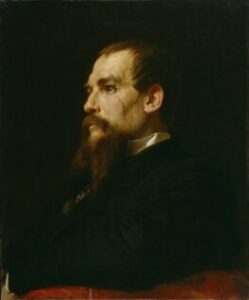
It is intriguing to think that Bent was perhaps angling for a portrait by the celebrated artist. Leighton had done a remarkable painting of another explorer, his friend Sir Richard Burton between 1872-1875, the years when Theodore Bent was studying at Oxford and thinking of his travels to come.
This Lindos/Leighton piece that he did for Black & White was divided into two instalments (an old journalistic trick) by the editors, wrapped around Leighton’s evocative pictures, and they appeared in the first issues. They are transcribed elsewhere on this site, and have probably not been much read since the 1890s; those who like Rhodes and Lindos will find them wide-ranging and valuable, if short.
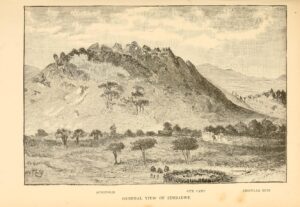
In an editorial (1 August 1891, p. 163), Black & White made an announcement with undisguised relish: “Mr. Theodore Bent, our special correspondent in Mashonaland, who is also exploring the grand, and as yet mysterious, remains at Zimbaye on behalf of several learned societies, has discovered images and pottery in the ruins which throw a new light upon their origin, and upon the nationality of the discoveries of, and settlers in, what is assumed to be the ancient land of Ophir. We await with interest the report of our correspondent, who, besides being a distinguished archaeologist, is also an excellent artist.”
In the end, Bent wrote just one article for Black & White, a rather muted one, “Pre-Mahomedan Relics – Excavations at the Great Zimbabwe” (2 April 1892), his best efforts being reserved for other publications, e.g. The Graphic. It is important, nevertheless, for some rare illustrations based on Mabel’s photographs, and is transcribed elsewhere on this site.
In the issue of 13 May 1897 (page 608), Black & White somberly concludes its relationship with the excavator of Great Zimbabwe, and much else: “Mr. Theodore Bent, the indefatigable explorer of South East Africa and Arabia, has passed in his prime at the early age of forty-four. The scenes of his wide travels embrace Greece, Asia Minor, Persia, Mashonaland, Abyssinia and Arabia, and various interesting volumes are left to attest the explorer’s learning and intrepidity.”
 Leave a comment or contact us about this article
Leave a comment or contact us about this article